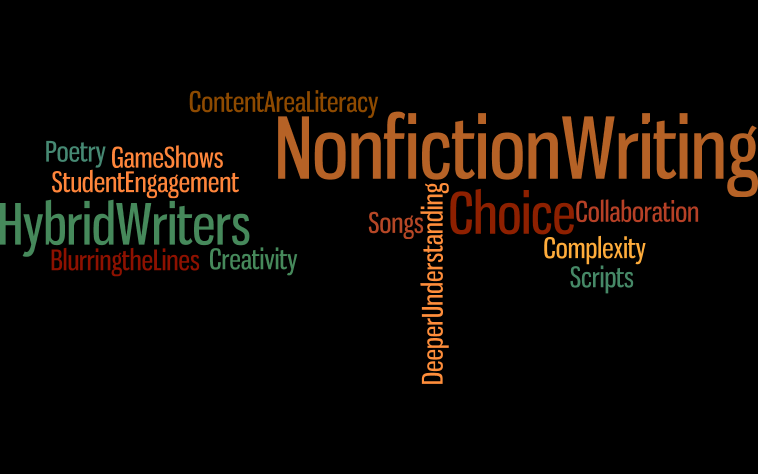Chapter 8: Redefining Nonfiction Writing
8.2 Becoming A Hybrid Teacher

During my years teaching fourth grade I have become, what you might call, a hybrid teacher. Hybrid, as defined, by vocabulary.com, is a mixture of two different things, resulting in something that has a little bit of both. My experiences as a teacher of English Language Arts have mixed with my work as a content area teacher resulting in teaching that combines content area study with many different forms of writing – poetry, songs, radio/television ads, scripts. As my students transform content material into literary forms of nonfiction, we use what we know from ELA classes as we explore the proper formats for various genres, understand and use English grammar to communicate our messages, and incorporate newly acquired content vocabulary into our writing.
As a content area teacher, I continue to facilitate comprehension of the conceptual material we are studying. Sometimes creativity is evident in the writing but comprehension and accuracy aren’t. As I check for understanding, I can see where there is a problem as a student grapples with explaining complicated concepts in their nonfiction writing. When I see a misunderstanding of the content that needs to be cleared up before they move on, or the need to provide suggestions for formatting, organizing, or revising their work before they create their final copy, a one-on-one conference generally provides the assistance needed. I can then leave students to explore their own ideas and possibilities.
Further, students understand that they have choices in the ways they demonstrate their understanding of the material they are studying. As a hybrid teacher, I no longer regard research reports as the single option open to nonfiction writers. In fact, students have added new forms of nonfiction writing to my repertoire. If I offer choices like a brochure, a Reader’s Theater, or a song, for their assignment, they may have another idea. “Could I write and perform a game show instead,” one student asked. Student motivation, enjoyment, and engagement is evident and the quality of their work is high when they make the choice on how to learn and to be assessed. Seeing how differently my students approach similar assignments and the creative thinking displayed by their work continues to amaze me.
Editor’s Note on Hybrid Picturebooks:
Sherry’s use of the word hybrid in this chapter is very interesting since it is a term that is sometimes applied to nonfiction picturebooks, as in hybrid nonfiction. Like Sherry’s definition the books labeled in this way combine two different things – in this case, different genres are combined to create a nonfiction piece. For instance, a poem may be used as the frame for the information presented as in Byrd Baylor’s Before You Came this Way. Or fantastical elements like magic school buses provide the vehicle for the reader to explore information about topics as varied as outer space and the human body (The Magic School Bus series by Joanna Cole and Bruce Degen). Narrative is also common in hybrid nonfiction texts. In some instances a particular story is narrated throughout the book with more scientific information presented separately or in a coda at the end (Rattlesnake Dance: True Tales, Mysteries, and Rattlesnake Ceremonies by Jennifer Owings Dewey); or information is conveyed using the first person as in Brian Karas’ Atlantic where the narrator is the Atlantic Ocean.
There are two important aspects, I think, to the use of hybrid nonfiction picturebooks in classrooms. These books are often part of the classroom or school library collection, and for young readers and writers may initially cause some confusion. Although these nonfiction books provide “real” information about a topic or content area, sometimes there were make-believe or “not real” elements in the books. Teachers need to be aware of the possibility for confusion with these books and may want to discuss how they have characteristics of both fiction and nonfiction.
Further, hybrid nonfiction picturebooks are often used as mentor texts for nonfiction writers because of the literary features present in them. For this reason hybrid nonfiction picturebooks can also be referred to as literary nonfiction, a form of nonfiction that uses narrative and other literary language and structures to present information. Thus, literary nonfiction in picturebook format provides young writers with examples of the author’s craft when writing nonfiction. Again, however, it is important that teachers be mindful of how the language of these texts might support or constrain how students take up the models in their own writing.